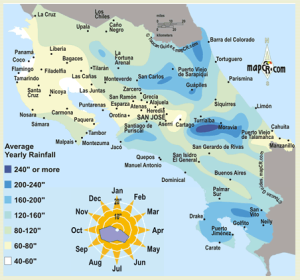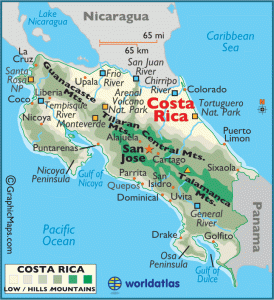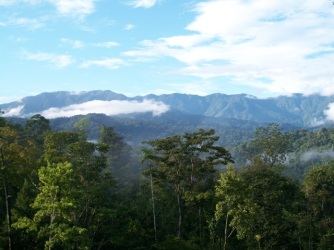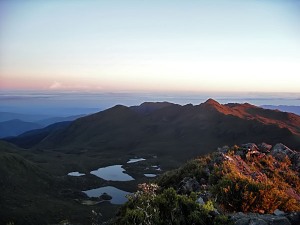General Landscape of Costa Rica
Costa Rica is a unique landscape that boasts everything from coastal lowlands, to breathtaking cloud forests, to towering volcanoes. These volcanoes take up much of the country, and much of the Central American Isthmus. This chain of volcanoes, the Central America Volcanic Arc, exists due to the subduction of the Cocos plate underneath the Caribbean plate. Although this is the primary plate boundary that causes this volcanic arc to keep growing, there are actually five different plate boundaries in this area of the globe. This means that there’s a ton of tectonic activity in and near Costa Rica, such as earthquakes and volcanic eruptions. The Cocos and Caribbean convergent plate boundary caused Costa Rica’s four volcanic mountain ranges to form. Part of this volcanic range is a horst due to extreme block-faulting. On the other side of this arc of volcanoes, the Arenal graben and the Valle Central make up a basin. The northern coastal plains of the country were formed millions of years ago from sediment and alluvial river deposits, some from Lake Nicaragua. Alluvial deposits are also plentiful due to the heavy rain that falls at higher altitudes and then flows down the mountain depositing sediment. These deposits are also partially comprised of heavy volcanic mudflows and a whole lot of volcanic ash due to the large amount of active volcanoes in Costa Rica.

Subduction of the Cocos plate under the Caribbean plate results in the Central America Volcanic Arc. Photo from http://sio.ucsd.edu/volcano/expedition/cocos.html.
Earth’s surface is always shifting due to movement of the plates and a whole slew of environmental factors such as weathering and erosion. We’ve seen what drastic changes can occur in just a short amount of time, such as when a volcano erupts. But what about the changes that will inevitably happen after we’re long gone?
Landscape of Costa Rica in 10,000 years
In 10,000 years, Costa Rica could look fairly different. The Cocos plate is currently moving at a rate of 9 centimeters per year in a northwest direction, subducting underneath the Caribbean plate. This means that in 10,000 years, the plate will have moved about 0.9 kilometers. I predict that Costa Rica’s volcanoes will remain active, and it is plausible that several new volcanoes will also form due to the large amount of subduction occurring at the plate boundaries. This may make it a poor choice for human inhabitance in the future.
Landscape of Costa Rica in 1,000,000 years
In 1,000,000 years, Costa Rica may look drastically different. By this time, the Cocos plate will have moved roughly 90 kilometers. Costa Rica formed as a string of volcanic islands that filled in around the bases over several million years. Based on this, I predict that the narrow land bridge will widen due to sea floor spreading and increased volcanic activity from the 90 kilometers of plate movement. The mountain ranges could also increase greatly in height, as evidence suggests that they have only reached their current height in the last two million years.

Subduction can be clearly seen in dark blue on both Cocos and Caribbean plates. The isthmus shows signs of widening above sea level in the future, in orange. photo from http://joidesresolution.org/node/1810.
Landscape of Costa Rica in 100,000,000 years
In 100,000,000 years, it’s almost impossible to fathom what Costa Rica might look like. The whole planet will be unrecognizable (if it’s still around). I predict that the isthmus will widen significantly because the zone of subduction will have moved a great deal, as will the point of origin for new volcanoes. At this point, the Cocos plate will be 9000 kilometers from where it is today, if it continues to move in the same direction and speed. This would cause the mountains to continue to increase in height. I predict that many new active volcanoes will form over this time period because of the movement of the plates overlapping so severely. I also think that the northern plains will continue to receive many alluvial and volcanic deposits.
Billions of years from now, I do not think that Costa Rica will be the paradise for flora and fauna that it currently is. Movements of the plates will drastically change this landscape, but only time will tell how that happens specifically.












